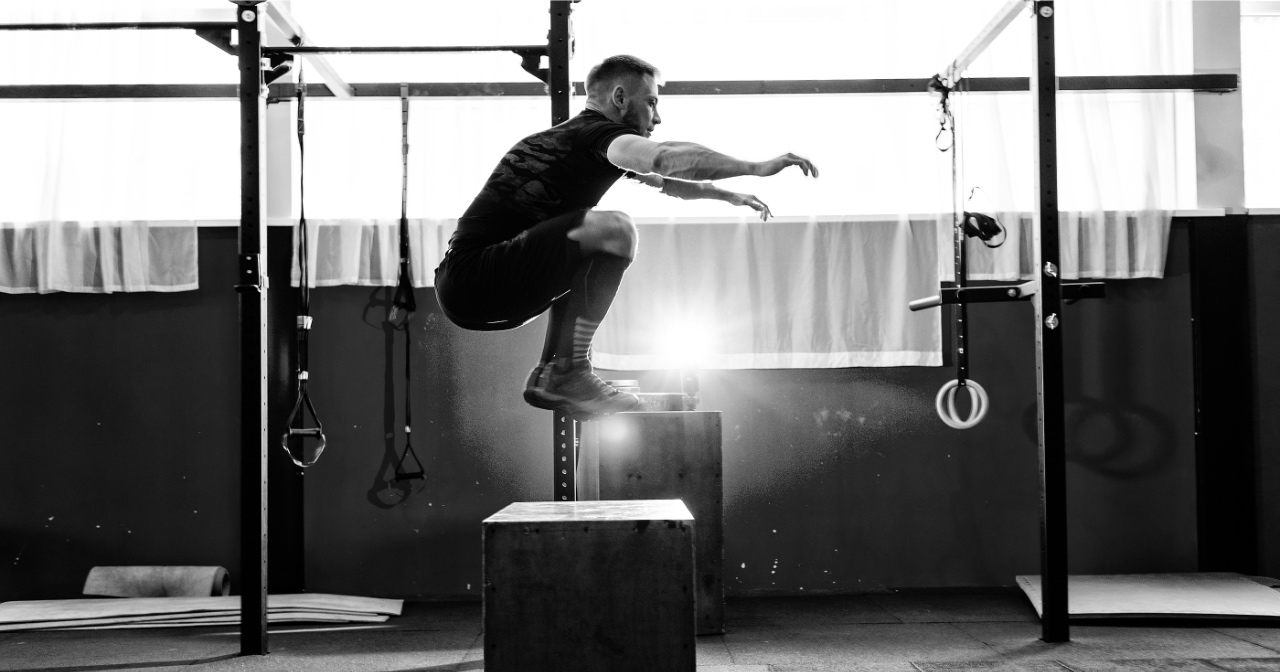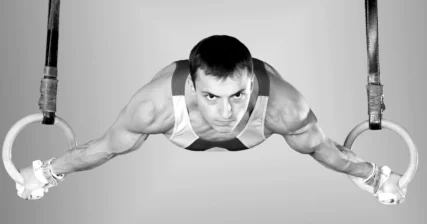Listen on: Apple Podcasts | Spotify
What are the benefits of plyometrics? Trainers and strength coaches often integrate plyometrics into their sports performance programs for athletes. Yet, the benefits of plyometrics aren’t exclusive to athletes.
When used appropriately, plyometric exercises add variety to programming, provide a safe and effective means of improving movement proficiency, and can better prepare your nervous system to produce maximal force during training sessions, athletic events, and in everyday life.
While I never rely exclusively on plyometrics for my online personal training programs, I often include at least one movement near the beginning of a workout. I’ll explain what plyometric exercise entails, the benefits you can expect, and my rationale for including certain exercises in my training program.

Feel Better Fast. Guaranteed.
Energy+, EDGE, and MentaBiotics make up the Happy Juice supplement stack, with ingredients clinically proven to:
- decrease anxiousness scores by 55%
- decrease irritability scores by 60%
- decrease fatigue by 64%
- decrease anger 54%
- decrease tension by 45%
- decrease confusion by 43%
- decrease overall distress by 49%
- increase good bacteria by 70%
- decrease negative mood by 105%
- increase positive mood by 211%
What are plyometrics?
Plyometrics are exercises performed with maximal speed and power for short periods of time. Though plyos are a type of power training, they aren’t the same as Olympic lifting or powerlifting.
Plyometrics definition: A quick and eccentric (muscle-lengthening) muscle contraction immediately followed by a swift and explosive concentric muscle contraction. While you quickly complete an eccentric movement, such as dropping to the bottom of a squat position, your muscles load with elastic energy. This storing of power from the stretch response is called “amortization.”
If you pause between the eccentric and concentric contractions too long, you lose the energy created from the amortization. To qualify as a plyometric exercise, you complete a maximal power, concentric movement immediately after the eccentric contraction.
The entire concentric-amortization-eccentric process is often referred to as the “stretch-shortening cycle.”
In reality, we leverage the stretch-shortening cycle in everyday life as well as in athletics. Once you become aware of it, you’ll see people use it to get out of chairs or move up the stairs, although they rarely use it to generate peak power.
Plyometric Exercises
Most plyometric training focuses on lower body movements, though some upper body plyometric movements exist. This is far from an exhaustive list, but the following are common plyometric exercises, many of which I include in my virtual personal training programs.
- Jump squats
- Triple broad jumps
- Clapping push-ups
- Depth jumps
- Jumping lunges
- Speed skater hops
- Box jumps
- Hurdle hops
- Single leg hurdle hops
- Jumping rope
- Medicine ball catch and toss
- Hand release pull-ups
Novice athletes and exercisers use their body weight as resistance, whereas intermediate and advanced athletes and exercisers may add additional resistance with bands, dumbbells, barbells, or a weight vest.
You can also vary the terrain to make plyometric exercises more challenging. Water, sand, and uneven surfaces add another layer or difficulty.
Though you often see people use them in gyms, I never recommend using a BOSU for plyometric exercises. It’s an accident waiting to happen and adds no functional value to a client’s programming unless they’re training for the circus. Sadly, though, I see many fitness professionals misuse the BOSU in this way.
What are the Benefits of Plyometrics?
Athletes have used plyometric training for decades to improve jump performance, lower body power, agility, and force production. Yet, non-athlete everyday Joe’s and Jane’s need these same abilities to function well in everyday life.
Plyometric movements challenge stability, balance, agility, speed, and power, which help you navigate life as much as an athlete navigates an athletic field.
In daily life, rapid force production is crucial in situations when balance needs to be corrected quickly after tripping, and its decline may be a major contributor to the loss of independence and falling accidents and injuries in older adults. Additionally, both agility and lower-extremity muscle power correlate well with balance, and having greater agility and more powerful legs thus likely indicates improved balance, which may decrease the risk of fractures and other fall-related injuries.
Vetrovsky T et al.
Research-supported benefits of plyometric training include:
- increased vertical jump height
- increased horizontal jump performance
- improved agility, or ability to change direction
- increased lower body maximum power, strength, and muscle mass
- increased bone density
- improved movement proficiency and coordination
- improved nervous system activation
- improved ankle stability
- improved stretch reflexes, which make the muscles more prepared for future plyometric or ballistic exercise
Plyos vs. Resistance Training
Though plyometric training does cause hypertrophy (muscle growth) and improves bone density, traditional strength training builds muscle and bone density much better.
Even if you add load with dumbbells or weighted vests, you can safely use only a fraction of the weight you can use with a standard resistance training exercise. Also, the time under tension during a plyometric exercise is much less than a resistance training exercise.
With standard strength training movements, a muscle group remains under tension throughout the entire set. With plyos, the muscles are only loaded when your body remains in contact with the ground.
That said, I do believe including some plyometric movements in a strength training program adds value.
Read also: 9 Reasons Strength Training is Critical for Long-Term Health and Fitness.
Plyometric Training for Non-Athletes
Plyometric movements:
- increase neural drive
- allow clients to practice fundamental movement techniques like jumping, hopping, and pressing safely, and
- increase core temperature, which improves overall strength.
Though plyos do not increase muscle mass or bone density like resistance training, they do enhance the effectiveness of a strength and conditioning program for non-athletes.
By including the plyos early in a training session, they help increase neural drive and core body temperature, which may improve performance throughout the rest of the workout. Plyos also help clients improve their movement patterns.
For example, one of my favorite plyometric exercises is the triple broad jump. Not only do you need good squat technique, but you also need:
- reasonable hip and hamstring range of motion
- good coordination between your arms and legs
- balance from right to left, so you jump and land with both feet, and
- good body awareness.
You also get immediate feedback on your technique. You know if you land favoring one foot versus landing with both, and immediately feel if you’ve stretched certain muscles to their range of motion limits.
On the other hand, even in gyms with limited space, you can usually find somewhere to do some box jumps.
In my opinion, it’s best to include a plyometric movement after the general warm-up and prep work, and before standard strength or Olympic lifts.
As an example, the image below is a week of Lumberjacked. I’ve included a plyometric exercise after the prep work in three out of the four training sessions.
Plyometric exercises add value to a well-designed training program, but they should only occupy a small part of the training plan for most people.
I recommend no more than two plyometric movements, so you have enough time to focus on building strength, mobility, muscle mass, and bone density during your training session.
References
Beato 2018, JSMPF.Pdf. https://air.unimi.it/retrieve/handle/2434/586318/1060988/Beato%202018%2c%20JSMPF.pdf. Accessed 19 Apr. 2021.
Lee, Ha Min, et al. “Effect of Plyometric versus Ankle Stability Exercises on Lower Limb Biomechanics in Taekwondo Demonstration Athletes with Functional Ankle Instability.” International Journal of Environmental Research and Public Health, vol. 17, no. 10, May 2020. PubMed Central, doi:10.3390/ijerph17103665.
Makaruk, Hubert, et al. “The Effects of Assisted and Resisted Plyometric Training Programs on Vertical Jump Performance in Adults: A Systematic Review and Meta-Analysis.” Journal of Sports Science & Medicine, vol. 19, no. 2, May 2020, pp. 347–57.
Zubac, Damir, et al. “Plyometric Exercise Improves Jumping Performance and Skeletal Muscle Contractile Properties in Seniors.” Journal of Musculoskeletal & Neuronal Interactions, vol. 19, no. 1, 2019, pp. 38–49.




